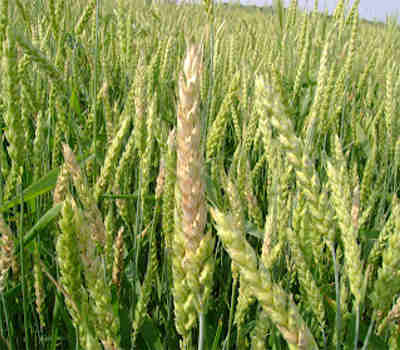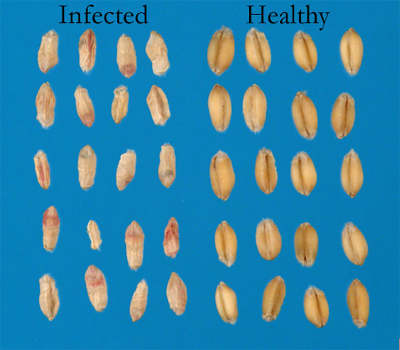By Nathan Kleczewski
Department of Crop Sciences
University of Illinois
Fusarium head blight (FHB) is an economically important disease affecting small grain production worldwide. The disease is predominantly caused by the fungus Fusarium graminearum in the United States, where infections can decrease yields and impact quality through reducing test weights and contaminating grain with mycotoxins including deoxyniveanol (DON-vomitoxin). Fusarium graminearum has a wide host range, and can cause ear, crown, and stalk rots in corn. The fungus grows and persists on residue from the previous year’s crop, which serves as a source of inoculum for small grains. The fungus produces spores on residue under periods of moderate to warm temperatures and wet conditions. Some of these spores are forcibly ejected into the air and can travel miles from the original source. Other spores are locally dispersed by wind and rain onto nearby plants.
FHB only affects the head, and infection is most severe when infection occurs during the flowering phase of crop development. If a spore lands on a wheat head at a susceptible growth stage, it germinates and can colonize the glumes, seed and rachis. Colonization of the rachis can result in a reduction of water and nutrient movement through the head, resulting in a bleaching of the head above the infection point. DON may be produced by some fungal strains, particularly if cycles of wet and dry weather follow infection. Severely affected grains will shrivel and turn pink to chalky white, thereby reducing test weights. These “tombstones” as they are often called, typically contain elevated levels of mycotoxins. However, healthy looking grains can also contain elevated levels of DON, which can result in loads being docked or rejected at the elevator. Consequently, managing FHB is driven by reducing DON levels to improve profits, reduce dockage, and improve the overall quality of grain in the chain.
Maximum reduction of DON is achieved when integrating multiple management practices.
Cultural practices
Due to the widespread distribution of F. graminearum in residues throughout the region, and the long distance transport of spores from sources of inoculum, practices including tillage and crop rotation have a marginal impact on FHB. However, these practices can reduce the amount of local inoculum. Fusarium graminearum does not grow as well on soybean residue as it does on small grain or corn residue. Consequently planting winter grains after soybeans is one management strategy many growers have implemented in recent years.
Resistant varieties
Resistance to FHB is complex and as a result, no immune varieties exist. Even the most resistant variety of wheat still can succumb to FHB; however, the amount of FHB and DON is significantly reduced when comparing a moderately resistant variety to a susceptible or moderately susceptible variety. Replicated university trials clearly show that producers can reduce FHB and DON by approximately 40-50% when using a variety with moderate resistance to FHB compared to susceptible checks. Check SCABSMART for variety ratings for your region and grain class.
Fungicide application
Fungicides can be used to suppress FHB; however there are a few caveats. First, suggested fungicides for managing FHB include Prosaro (Bayer), Caramba (BASF), and Miravis Ace (Syngenta). Trials indicate that these fungicides can suppress FHB when applied following label guidelines. Replicated university trials indicate that on average, the aforementioned suggested fungicides will suppress DON by approximately 42-45% compared to a non-treated check. Second, the timing is essential. Research supported by the United States Wheat and Barley Scab Initiative indicates that the optimal window for the aforementioned fungicides is between Feekes 10.5.1 (beginning flower) to five days after this point. Timing this application is difficult, as wheat often does not flower uniformly within a field and secondary tillers can flower several days after primary tillers. In general, the application should be timed to hit the field once 50% of the main tillers have started to flower. I typically tell producers that flowering generally starts 3-4 days after head emergence.
Biological control
There is work being done to assess various biologicals on FHB and DON. This is an active area of research and development by researchers and industry.
The Fusarium head blight forecasting website http://www.wheatscab.psu.edu/ can be used to infer the likelihood that a fungicide for FHB is required during the season. Statewide commentaries are posted. Remember that when using this tool, you should input the appropriate class of wheat that you have in your field, and realize that the tool is predicting the risk of FHB for wheat flowering that day. Data are uploaded during the morning, meaning that the most accurate daily forecasts are available around lunchtime in many areas.
Images
1. Wheat head with FHB. Note bleaching and pinkish discoloration of the glumes. Photo N. Kleczewski.

2. Grain infected by Fusarium graminearum ve healthy grain. Photo Schmale III, D.G. and G.C. Bergstrom. 2003 . Fusarium head blight in wheat. The Plant Health Instructor. DOI:10.1094/PHI-I-2003-0612-01 Updated 2010

Source : illinois.edu